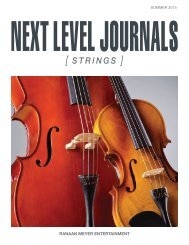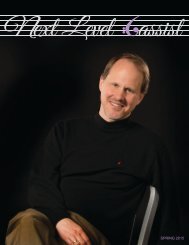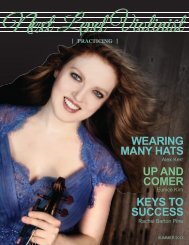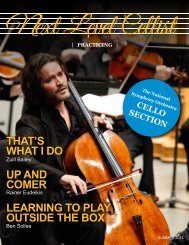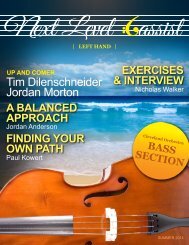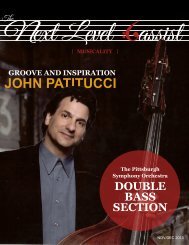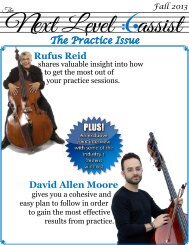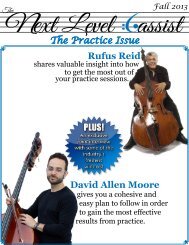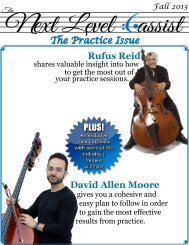Next Level Cellist Musicality Issue
Featuring articles by Alisa Weilerstein and Efe Baltacigil, a spotlight on the Chicago Symphony Cello section, and a duet by Ranaan Meyer
Featuring articles by Alisa Weilerstein and Efe Baltacigil, a spotlight on the Chicago Symphony Cello section, and a duet by Ranaan Meyer
You also want an ePaper? Increase the reach of your titles
YUMPU automatically turns print PDFs into web optimized ePapers that Google loves.
ODE TO JOY<br />
Never hit the last D,<br />
always finish it humbly<br />
and respectfully.<br />
Some 27 years later, I still remember that<br />
moment, and he was so right! The only time<br />
I allow this to happen is when I’m told to do<br />
it by the composer. It’s very important that<br />
you have part of your mind on these tiny<br />
details. The little rules and bits of information<br />
accumulate over time, and hopefully combine<br />
with a good environment of friends and<br />
fellow musicians that you can use to stay<br />
connected to inspiration. The world we’re<br />
living in, with cell phones and computers,<br />
Facebook and other distractions, can get<br />
in the way of focusing on the purity of an<br />
individual phrase. In a way, music is a therapy<br />
to prevent yourself getting carried away by<br />
the world around you.<br />
While in high school in Istanbul I met a<br />
German cellist named Werner Thomas-<br />
Mifune for whom I played the Saint-Saens<br />
concerto. What was supposed to be a<br />
30 minute lesson ended up being almost<br />
2 hours long! He talked about the importance<br />
of the distances between the notes. He made<br />
distinctions between how you would play<br />
a half step versus a whole step. This lesson<br />
moved me so much that I couldn’t even fall<br />
asleep for about a week! That first phrase is<br />
a great example of how half steps and whole<br />
steps create this simple scale down that is<br />
filled with complex feeling and character. The<br />
minute you put this under a microscope and<br />
look at the notes you start to appreciate the<br />
differences between these intervals, you can<br />
begin to feel intimacy with the phrase.<br />
to singing, that ideal we’re always trying to<br />
emulate. The larger the interval, the more<br />
effort is required to sing it, and therefore<br />
the more attention and love we can put into<br />
playing it. It’s a crucial part of phrasing.<br />
If you truly understand the nuance that<br />
comes from these intervals, you can slow<br />
down your perception of the music and<br />
experience this wonderful close-up view.<br />
You start to appreciate what the composer<br />
had to say. You can’t live in this close-up<br />
world all the time, you have to go back to<br />
real time to get a larger picture, but it’s an<br />
essential part of learning and developing<br />
your musical vocabulary. There are tensions<br />
between notes, and if you can even halfway<br />
understand those distances, it will drastically<br />
affect your phrasing.<br />
Another of the incredibly powerful tools we<br />
have as musicians is the manipulation of time.<br />
Time, and the way you use it, expand or<br />
compress it, is essential to mastering classical<br />
music, especially when it’s very detailed and<br />
written out. However you control it and<br />
which sections you focus on create the style<br />
of music you are playing. Classical, Romantic,<br />
Modern, Baroque, all are affected by the way<br />
you take or give time. [Editor’s note: for a<br />
more detailed discussion of time, check out<br />
John Patitucci’s article Groove and Inspiration<br />
in <strong>Next</strong> <strong>Level</strong> Bassist.]<br />
My teacher at Curtis, Peter Wiley, really kept<br />
beyond execution, and that’s why it’s so<br />
important that you find inspiration<br />
in your life.<br />
Finally, I believe an invaluable tool for<br />
becoming a great musician is improvisation.<br />
It probably sounds scary if it’s unfamiliar,<br />
but ultimately, improvising and classical<br />
music are both just types of music. It doesn’t<br />
matter what genre you’re playing, in the end<br />
hopefully you’re trying to make music. It all<br />
comes down to the same core. If you can learn<br />
to do that, regardless of what your medium<br />
is (bow, pizzicato, cello, voice, whatever!),<br />
then you’re doing the best you can. As long<br />
as you can move the person that’s hearing<br />
you emotionally, then mission accomplished.<br />
The more easily and more readily you can get<br />
into that zone, the more successful you will<br />
become and the more success you can have.<br />
A WORD ABOUT SOUND<br />
AND EDUCATION<br />
One of my great advantages growing up was<br />
being around two phenomenal bass players,<br />
my father and brother. Why does it matter?<br />
I think it’s very important - the bass is by<br />
definition the foundation of music. It holds<br />
the whole harmony, and that is often a job we<br />
cellists have to perform as well. Even when<br />
you play the melody, if you’re not aware of<br />
where your feet are meant to be grounded,<br />
you will sound like you don’t know where<br />
you’re headed. I think<br />
it’s an essential part<br />
of musicianship, the<br />
sense of direction.<br />
It gives you a good<br />
compass when you are<br />
aware of the bass line.<br />
Consider why the line moves in the directions<br />
it moves, and why the color of one whole step<br />
is used instead of a half step. When you begin<br />
to contemplate why it was written a certain<br />
way, you start to care deeply about the music,<br />
become one with what the composer is trying<br />
to say. Whole steps and half steps are only a<br />
tiny part of the big picture of music - when<br />
you expand to look at other intervals, you<br />
can start to think about how the music relates<br />
Mi - Re - Do (whole steps) followed by a half step to Si and back to Do<br />
my focus on slowing the music down and<br />
finding the meaning. He really drilled me on<br />
left hand and right hand subtleties, like using<br />
a different quality of vibrato on each note,<br />
and playing different notes with different bow<br />
speeds to shape the phrase. There is a limitless<br />
potential on the cello for realizing phrases,<br />
and all the etudes and exercises in the world<br />
can’t come close to the complexity of playing<br />
one phrase of music with meaning. It goes<br />
I had a lot of wonderful<br />
teachers of harmony,<br />
theory, and counterpoint at Curtis. They<br />
all encouraged me to understand (or at least<br />
try to) what was going on harmonically in the<br />
music I was performing or hearing. A good<br />
entry point is Bach’s cello suites, because they<br />
are complex but still have only one or two<br />
lines going at once.<br />
I think it helps a great deal to be familiar<br />
12 SPRING 2014 NEXT LEVEL CELLIST




